#Fish Tripe
Text
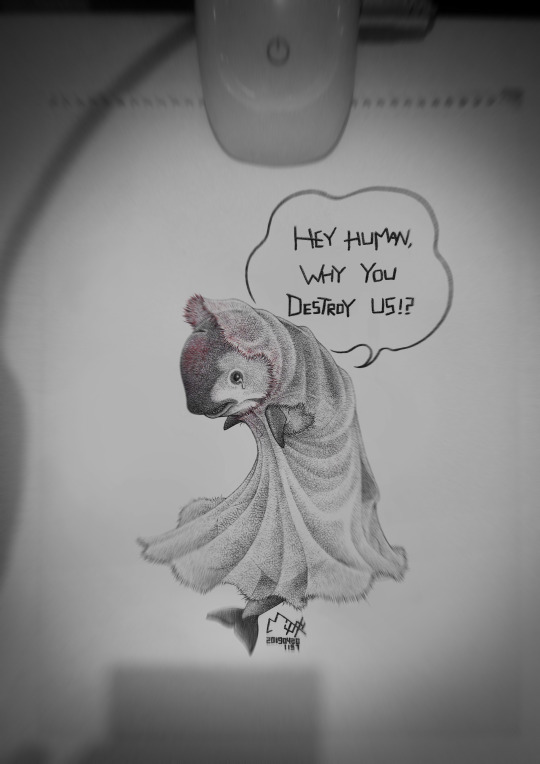
International Save The Vaquita Day
HEY HUMAN, SEE WHAT YOU DO!?
ANIMAN - FISHNET PHOCOENA 魚網豚
Instagram: milkdongcomics
Facebook: Milk DoNg Comics
#International Save The Vaquita Day#鼠海豚#Phocoena Sinus#瀕危#Endangered#剩下約10條#Around 10 Only Left#漁網#Fish Net#非法捕魚#Illegal Fishing#石首魚#Totoaba Macdonaldi#花膠#Fish Tripe#ANIMAN#HEY HUMAN SEE WHAT YOU DO!?#Milk DoNg#Milk DoNg Comics
2 notes
·
View notes
Text
Saw the advertisement on television promoting the bundle deal of three dishes by Tun Xiang Hokkien Delights (豚香福建馆). Thought that it was a good deal plus the fact I have not been to the place yet. Dragged mum along to Northpoint City mall on a hot weekend afternoon since I couldn't possibly finish the set meal alone.

Upon seated, the wait staff informed us that you can scan the QR code on the table to access the digital menu plus order. Placed ordered for the Bundled Deal (S$28.80++) consisting of the Signature Hokkien Mee, Iberico Pork Fried Beancurd and White Pepper Collagen Pig Stomach Soup.
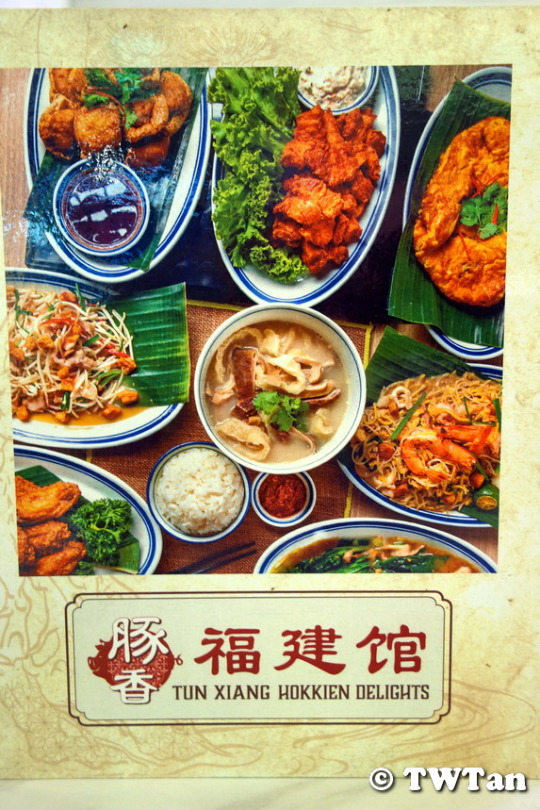

The Signature Hokkien Mee (招牌黑猪福建面) came with a mixture of yellow noodles and bee hoon (rice vermicelli) served over banana leaf. At a glance, one can spot prawns, squids, matchstick sized pork and plenty of deep-fried pork lards soaked in the gravy. While the overall taste is decent, the flavour profile of the prawn is not pronounced enough like they didn’t use enough prawn heads and shells to render out the prawn oil.

Both of us enjoyed the Iberico Pork Fried Beancurd (酥炸黑猪酿卜) a lot. The minced pork is well seasoned and stuffed into fried bean curd puffs before going into hot oil. The puff outside is crispy while the meat is juicy. Remember to dip the whole thing into the sweet thick sauce for the complete package before devouring it.
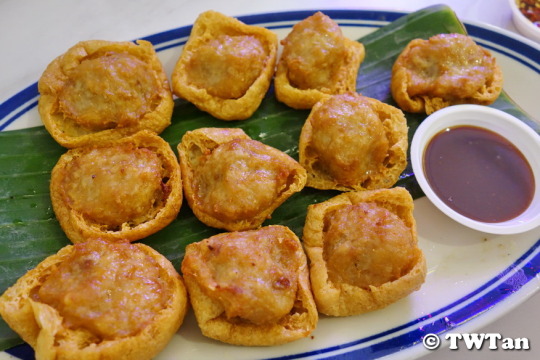
Was reminded that the White Pepper Collagen Pig Stomach Soup (胶原胡椒猪肚汤) is hot when it was served. It came with thinly sliced Iberico pork, tripe, fish maw and garnished with coriander and chilli. Taking a sip of the soup, I can detect the stickiness of the collagen on the lips and the spiciness of peppercorns though I would have enjoyed a stronger peppery taste. Both the tripe and pork were tender enough but the fish maw needs a longer cooking time to get to the softer texture I preferred.
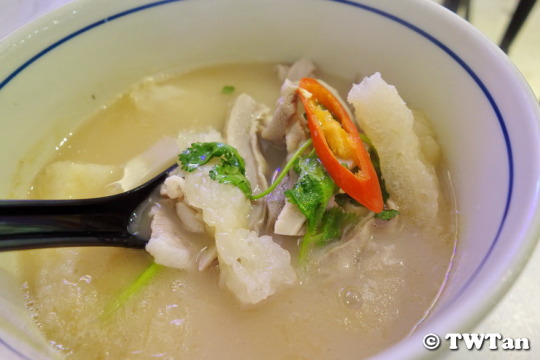

While I enjoyed the meal, mum is a lot harder to please. She claims that the noodles look like last night leftover and other than the fried bean curd, I don’t think she like the other two dishes.
#Tun Xiang Hokkien Delights#豚香福建馆#Northpoint City#Bundled Deal#Signature Hokkien Mee#招牌黑猪福建面#Yellow Noodles#Bee Hoon#Rice Vermicelli#Prawn#Squid#Pork#Pork Lard#Iberico Pork Fried Beancurd#酥炸黑猪酿卜#White Pepper Collagen Pig Stomach Soup#胶原胡椒猪肚汤#Tripe#Fish Maw#Food#Buffetlicious
31 notes
·
View notes
Note
hii mr radguy, local korean here to say that wrapping meat like that is indeed part of the experience!! it's not specifically for bulgogi, but just about any korean bbq! the salty oil sauce is also seasame oil mixed with grinded black pepper and a bit of salt, and is a staple dipping sauce for all korean bbq. it's also common to wrap the meat in perilla leaves, which is my personal favorite! it adds a faint minty aftertaste that really cleanses the palate, but it might be too earthy for some folks.
(also sorry for the infodump! i get excited to share anything about my culture)
AH please don't apologize, this is all very good information. Korean culture is a bit unknown to me because there aren't as many Korean immigrants in my slice of the world as there are people/families from other parts of southern and eastern Asia, so I don't get exposed to it very often, sadly... Absolutely love what I've tried of the food though!! Wish the Korean BBQ place was closer so I could check out other stuff on the menu more often...
If I get the chance to wrap the meat in perilla leaves I'll be sure to give it a go!! I really enjoy trying new types of food; there hasn't been much that I've tried before and didn't like tbh haha
Thank you for sharing ^^
#asks#The only food I have a hard time with is anything with eyes...#Tripe. tongue. tentacles. fish with scales still on them. crustaceans = no problem + very yummy#Something with the eyes still on it when it's served.... ehh..........
16 notes
·
View notes
Text
#I’m pescatarian technically but I occasionally (like once or twice a year) eat offals like tripe and liver#meat makes me sick to my stomach I loveeee fish and seafood tho
7 notes
·
View notes
Text
different meats are different gods btw
#the actual animals are of course but that’s different. what i am saying is that lamb is a spring god venison is venial rabbit is sporting#pork belly is bacchantic. beef is a bearded barley-monarch and a white fish is a moon goddess#sorry. i don’t know. offal and tripe are gods too even if the world ignores them#kind death in the form of blood gizzard and the song of liver. skin handlers#nothing is wasted. can’t you hear? living things#chicken is a young male god in flight. pretty lean white thing#veal dances in blood. we had cockerel for christmas dinner once and it’s never left me. plumed punch#we had pork this year and when my grandfather asked what the cut was my father mimed it on his own body. my stars. gods
5 notes
·
View notes
Text
When Mischief isn't feeling well she gets so picky about her food touching?
Got her some eggs and once she ate those she was happy to eat other things but my sister had put three kinds of treats (all oat or fish based and safe for her just different textures) and she wouldn't eat it until she took all the pieces and separated them out.
Such a weirdly picky dog
#when she goes anorexic we do whatever food she will eat.#which is usually eggs#or its plain oats or plain fish or tripe#one of the four things
0 notes
Text
Watch "Asmr massive fufu eating sounds | Brown Poundo Yam FUFU & Banga soup with SHAKKI, COW SKIN & FISH" on YouTube
youtube
#brown pounded yam#fufu#banga soup#shakki#shaki#cow tripe#tripe#cow skin#kpomo#fish#repost#african cuisine#african food#Youtube
0 notes
Text
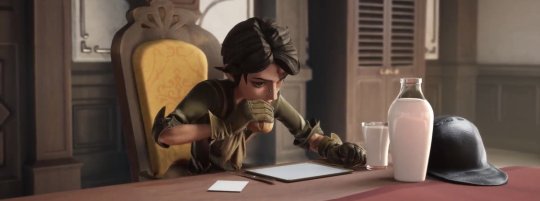
Analysis of the Food/Diet of the Lower Class in the Victorian era
(It was a bit tricky for me to find sufficiently detailed answers about the time and group I was looking for, as I wanted a bit more than the basics. Apologies for any mistakes)
Bread was a staple of the lower-class diet, such as wholemeal, rye bread, unleavened bread (like oatcakes), etc.. For the poor, it was often made of cheap-quality flour and likely denser than modern bread.
These could be supplemented with whatever vegetables that were cheapest as well as locally available at that time of year. Onions were among the cheapest (half penny for a dozen, cheaper if they were bruised) and available all year. They were more expensive in late spring, at which point they could be substituted by leeks. Watercress was another cheap staple (halfpenny for 4 bunches from April to January/February) and were regularly eaten at breakfast. Cabbage was cheap and easily available, along with broccoli, with lettuce and radishes available in summer. Carrots and turnips were inexpensive staples, especially in winter, and they along with cabbage were often used in stews and soups.
As for fruit, apples were the cheapest and most commonly available (from August to May). Cherries were also fairly cheap (from May to July). Pears, blackberries, and plums were available throughout autumn. Then there were gooseberries, plums and greengages (in late September), raspberries, and strawberries. Not all fruits were affordable, like oranges, which were imported from Spain in winter but were expensive and often given as gifts, and pineapples, which were a sign of wealth.
Potatoes were another staple and were prepared in various ways, including boiled, mashed, roasted, or fried. They grew well in Britain’s mild weather, making them easy to produce and sell, meaning they were cheap and thus became a frequent meal.
In terms of meat, the lower class ate it infrequently, maybe once a week, with the worst off even less often. Pork was 1 of the most common types of meat, when it could be afforded.
As a result, the poor made the most of it (using and eating every part of it). For example, a cook would boil a piece of beef or mutton with vegetables one day (probably Sunday, the only day many people had off from work), then return to the boiling pot the next day and skim the fat off from the top to be used for frying or pie crusts. Then he or she could set the liquid back to boiling, adding a stingy amount of oatmeal (one recipe recommends a tablespoon of oatmeal for every pint of liquid) to produce another nourishing meal from the broth. Recipes call it a pot liquor soup; we’d more likely call it gruel.
Gruel, made by boiling grains, like oats, rice, or barley, in water or milk, was a common food option for the poor as it required minimal ingredients and was easy to prepare. It often served as a breakfast or basic meal.
Porridge refers to a thicker and more substantial version of cooked grains, usually oats, in water or milk. It was typically cooked for a longer amount of time, resulting in a creamier and heartier consistency. It was also a popular breakfast choice due to it being nutritious and filling.
They tended to buy cuts and trimmings of meat no one else wanted, which were referred to as “block ornaments”. Examples included sheep’s organs, shanks, gristly bits, and heads. Most of these cuts were tough or didn’t have much meat on them, but they could produce a filling broth. Tripe (lining of stomach of animals like cattle, sheep, and pig), liver, meat on the bone (shin or cheek), and offal (aka organ meats like brains, hearts, sweetbreads, liver, kidneys, lungs, and intestines) were also cheap.
Chicken was rare, as the birds were kept for eggs, and usually not eaten unless the bird stopped laying eggs.
Later in the Victorian era, bacon became a popular choice at breakfast (alongside kippers aka a type of fish made from herring, eggs, and porridge).
Drippings was another common part of the lower class diet. Drippings refer to the fat that is collected as a result of cooking meat. When meat, such as beef, pork, or poultry, is roasted or grilled, the fat present in the meat melts and drips down into the pan or tray. This fat is then collected and saved, typically in a container or jar, for later use. They add flavor and richness to dishes and are commonly used for making gravies, sauces, or to enhance the flavor of roasted vegetables, as a few examples.
Since meat was a luxury, the lower class tended to go for cheaper proteins, like eggs and legumes.
Many East End homes kept hens in their backyards, with a couple hens able to produce up to a dozen eggs per home per week. Hard cheeses like cheddar was produced countrywide and so available all year round, meaning it was able to enter the diet of the lower class. It was a good protein, kept well, and even stale it could be eaten toasted with bread.
Regarding legumes (ex: beans, peas, peanuts, lentils, etc…), they were a cost-effective source of protein, fiber, and nutrients. Dried legumes were more affordable and available all year round. Beans (good from July to September) were a staple for many lower class, often cooked in stews, soups, or baked dishes. Peas (affordable from June to July) and lentils were also commonly consumed.
In terms of drinks, tea was very common. It became more affordable with the help of increased trade, improved transportation, and advancements in production methods. The poor drank tea that tended to be weaker, as they reused the tea leaves several times before disposing of them. Black tea was common, the most popular being those imported from countries like China and India.
Milk was widely consumed but not usually in large quantities, due to cost and adulteration fears (aka fear of contamination). Beer was also common (made with low alcohol content so you didn’t get drunk), even for women and older children, as water wasn’t safe to drink back them (easily contaminated, but the brewing process killed off the germs). Coffee was another option, but it tended to be more expensive than tea, beer, or milk.
Sugar became cheaper at least after 1874, but still tended to be relatively expensive, especially for those on lower incomes. Thus it remained more of a luxury item and consumed in mostly smaller quantities or for special occasions.
Butter, like sugar, would’ve also been considered a relatively expensive item, and thus not as widely consumed. Instead, they used cheaper options of fat, like lard and dripping.
Nuts were another slightly more expensive item. But there were some options if a poorer individual could afford them. Chestnuts were the most common (favorite street snack in chestnut season, running from September to January). There were also filberts and hazelnuts (available from October to May) and walnuts (seasonal). Imported almonds and brazil nuts were more expensive, but commonly consumed around Christmas as a “treat”.
Even if they could afford things like sugar, butter, or nuts, the lower class likely would’ve typically used their income on more basic necessities and things they needed for their job or life.
Individuals were paid on Saturday, and that plus the absence of refrigeration affected the weekly menu. It’s possible the lower class at least may have possessed basic cooking utensils, like a skillet, pot, or kettle. The ‘best’ and relatively most expensive meals were taken on Saturday evening and Sunday, though the poorest would often buy food at the end of Saturday trading, at the cheapest possible prices. Menu choices became cheaper through the week: purchases of food would diminish in quantity as the food budget shrank, and meat would often only be purchased once a week, though vegetables and fruit were usually purchased and consumed on a daily basis.
The very poor might purchase cheaper older fruits, vegetables, and meat on the verge of edibility, though this didn’t really diminish the nutrients in them much.
The lack of refrigeration facilities meant that meats eaten hot on any one day were almost inevitably consumed (cold) on the second day. Any more leftovers were, due to incipient spoilage, curried or hashed on the third day. Spices and the higher heat involved in frying the hash would disguise any taint to the meat and lessen the chances of food poisoning.
Men worked on average 9–10 hours per day for 5.5-6 days a week, giving a range from 50–60 hours of physical activity per week. Factoring in the walk to and from work increases the range of total hours of work-related physical activity up to 55–70 hours per week. They likely required around 5000 calories a day.
The daily wage for poor miners back then may have been around 3-4 shillings, with the weekly wage then around 18-24 shillings. In dollars, 3-4 shillings was likely around $1. In today’s money, 3-4 shillings a day may be around £4 to £5 or $5 to $6.
#idv#identity v#norton campbell#prospector#fool's gold#fools gold#hunter norton#idv norton#identity v norton#idv prospector#identity v prospector#idv fool's gold#identity v fool's gold#idv fools gold#identity v fools gold#sirenjose analyses and theories
150 notes
·
View notes
Note
How would the cats get rid of the bile to prepare a prey item for food? The liver is one of the best items to use for gravy--my family uses our roasted Turkey's liver as a gravy base every year and to have to throw it out cause someone fucked up while on kitchen duty would suck.
Not all animals will actually have gallbladders, but removing one from the liver is as easy as just chopping it off when you get to the processing part. It'll be down on the bottom of the liver, usually pear-shaped, and a dark greenish color. Sorreltail, a sapient cat with her great sense of smell, could tell it apart from the surrounding meat with her eyes closed.
I do have to stress, though, you CAN eat bile. You don't have to have the cats toss that, that is a thing they can eat. Again it's not nail polish remover like the Erins think it is. It's bitter, but it's used in human food. You just balance out the bitterness with spice and sweetness.
This is papaitan, from the Philippines, made with tripe and bile,

Bile is also said to have anti-inflammatory effects and be a generally healthy food, too. I can see ShadowClan in particular really liking to cook with this, especially for a sick cat. They like bitter and spicy tastes a lot more than other Clans. Their version of chicken noodle soup.
Also; a lot of animals do not have gallbladders. Here's a short list of common prey animals and their gallbladder status;
Rabbits = No
Rats = No
Mouse = Yes
Shrew = Yes
Deer = No
Pigeon = No
Quail = Yes
Carp = Yes BUT DO NOT EAT THESE
CARP GALL BLADDERS CAUSE FOOD POISONING. ALL species, everywhere. This includes goldfish. Your cat will live if they swallow a goldfish or eat a gallbladder once or twice, but it will make them sick. Process this fish before a Clan cat eats it.
(Side note: It's actually kind of funny how carp keeps coming up as The "Fuck You" Animal in all of these. They're full of seizure-causing anti-nutrients, their gallbladders are poison, what am I going to find next?)
The gallbladder in fish is really easy to find btw, they're usually massive, round, and dark green. If you gut fish regularly it's like... right in the "chest." Also you can poke it open and soak little paper squares in it and then they spin around in water, it's very cool
Bile is for the breakdown of fats, and a gallbladder is for the storage and concentration of bile. Generally, herbivores are more likely to lack gallbladders, because their liver just dumps the weak bile they have directly into their intestines. The mystery of why rats don't have gallbladders has actually vexxed scientists for like 100 years, btw.
Some herbivores (deer especially) have a very tiny "pouch" for bile called a diverticulum. But unlike the gallbladder, it doesn't concentrate it, just stores a little extra. Some hunters will nick this and think they tore open a gallbladder, but they did not.
96 notes
·
View notes
Text
twst + hotpot 🥘
assigning each twst cast member a hot-pot food item
cw: mentions of food, cultural foods (?), none really
notes: loosely based on canon favorite foods, mostly based on vibes + my own experience - this is not that serious, don’t come for me please. happy very late lunar new year and 新年快乐 to those who celebrate. these have been turning around in my head for a while - longer dorm hotpot hcs to come. also hi long time no see.
feel free to drop an ask or to add on! likes + rbs are appreciated <3
wc: ~90 words. hc format.

• Heartslabyul ♕:
Riddle: Bamboo Shoots
Trey: Tofu Skin
Cater: Mung Bean Vermicelli
Ace: Shrimp Paste
Deuce: Quail Eggs
• Savanaclaw 𓃮:
Leona: Besides all different kinds of meat, blood tofu.
Ruggie: Fresh Tofu Sheets
Jack: Winter Melon
• Octavinelle 𓆝 :
Azul: Fish Tofu
Jade: Shiitake Mushrooms
Floyd: Baby Octopus
• Scarabia 𓆣:
Kalim: Lotus Root
Jamil: Cuttlefish Balls
• Pomefiore ❦:Vil: Black Wood Ears
Rook: Tripe
Epel: Beef Tendon Balls
• Ignihyde ☠︎:
Iida: Sweet potato
Ortho: Napa Cabbage (if he could eat)
• Diasomnia 𓆈:
Malleus: Frozen Tofu
Lilia: Tomatoes
Silver: King Oyster Mushrooms
Sebek: Daikon Radish
graphic by @/animatedglittergraphics-n-more
48 notes
·
View notes
Text

International Save The Vaquita Day 2023 國際拯救加灣鼠海豚日
HEY HUMAN, SEE WHAT YOU DO!?
ANIMAN - FISHNET PHOCOENA
Instagram: milkdongcomics
Facebook: Milk DoNg Comics
#International Save The Vaquita Day#國際拯救加灣鼠海豚日#鼠海豚#Phocoena Sinus#極危#Critically Endangered#剩下約10條#Around 10 Only Left#漁網#Fish Net#非法捕魚#Illegal Fishing#石首魚#Totoaba Macdonaldi#花膠#Fish Tripe#ANIMAN#HEY HUMAN SEE WHAT YOU DO!?#Milk DoNg#Milk DoNg Comics#Art#Drawing#Sketching#Painting#Illustration#Character Design#Color Pencil
0 notes
Text
The Crew and Bulgarian cuisine in Varna
First off, Jonathan. I think he would want to try Shkembe (Bulgarian tripe soup), and love it. Tripe soup isn't common in England, but we know he is open to new experiences and that he is daring. Plus, he used to be poor and it's likely he's been having similar cuts of meat, which was most affordable in England. Tripe soup has variations in Southeastern Europe and the Middle East, but the Bulgarian version adds paprika in particular and, in fact, claims the more paprika, the better. (imo it's up to your spice taste)
Is he trying any in Varna? I say yes. Because tripe soup places are traditionally open all night and morning because they're commonly visited around dawn by graveyard-shift working-class people, sailors, and people who drank the night away. Because it settles the stomach.
After Mina's dawn report, he sometimes goes there to eat, after another night of being up with Mina. He's not been very hungry, but he tries to eat... He needs his strength. He of course asks for extra paprika. He needs to feel somewhat alive.
I see Mina liking fish, and Varna is a sea town. I base this on her surname and her strong affinity with the seashore, mostly. She would really like deep-fried sprats (tsatsa), herring-like fish with lemon and fries. Sort of reminds her of home with its fish and chips. She would like the various Black Sea fishes like shad and goby, and mussels. She avoids going out when she's awake, but Jonathan knows her tastes and brings her seafood.
She tries to eat like a normal human, for him. It gets less and less easier.
Van Helsing may have tried a few Balkan dishes before but I think that he would like local Lozomi Sarmi. Rice/veggie/herb-stuffed grape leaves are a staple starter in the Balkans. I see him in general preferring vegetarian dishes but he'll have some of the ground meat stuffed ones. Dipped in Bulgarian yogurt.
Quincey is a meat lover to me and I can see him loving Meshana Skara, aka assorted meat dish, that includes meatballs, the famous kebapche, steak, and pita. Arthur isn't a lover of the local cuisine but he will try it if his friends are having it. It's what he usually does in their travels. But he eats plenty of Bulgarian yogurt, Kiselo Mlyako. It's sour, and he prefers it that way, than adding honey.
Jack likes trying new things and assessing them, he'll try almost anything once. It's autumn and getting chillier at the seaport, so he opts for warmer food like Gyuvech, a vegetable casserole with beef and potatoes in red sauce.
His insomnia sometimes brings him to overnight restaurants. Sometimes, after dawn, he sees Jonathan there. They sit and eat and smoke together, mostly in silence.
#I have regularly tried all variations of those they are so good#in general balkan and middle eastern cuisine rule#dracula daily#dracula#mina harker#jonathan harker#jack seward#arthur holmwood#quincey morris#abraham van helsing#bulgaria#balkan culture#balkan cuisine
142 notes
·
View notes
Text
omg wait this is so sweet zeng shunxi had his (early birthday?) fan meeting yesterday and cheng yi filmed a video as li lianhua wishing xiaobao happy birthday 🥹 (x)
translation: fang xiaobao, your birthday's coming up, isn't it? then, do you want to eat braised fish in red soup this time, or pork tripe chicken stew? hm, you should eat a bowl of longevity noodles; you've grown another year older. i wish you a happy birthday—may you be safe and sound year after year, and get better as you grow(?). jiayou!
#mysterious lotus casebook#cheng yi#li lianhua#zeng shunxi#fang duobing#fanghua#lhl#rui rambles#yes i did in fact forget to tl the last part lol oops
90 notes
·
View notes
Text
Ok this fish poll has me intrigued... a lot of people saying that, if they were told they were having meat, they wouldn't expect to get fish. I can't really relate to that at all, Fish is as regular as chicken or pork in my diet, it would be a reasonable expectation for me. Maybe for people living far inland, seafood is considered a special-occasion food, and so they separate it from meat in their mind.
Also I have no idea if most people in Australia consider fish to be meat or not honestly. All I know is fish is a common protein in my parents cuisine (Southeast asian) and our family would all consider it meat. but how much of my definition is influenced by my nationality and how much by my culture...
Another thing I read in the notes of that post was "offal isn't meat"? Like, I've eaten liver, heart, tripe, I never wouldve thought someone doesnt consider them meat. odd textures for sure, but still meaty.. I guess the idea for some people is that meat only includes muscle/fat/connective tissue, and not specialised organs. I dunno what to think of that
And then there was someone saying freshwater fish are meat and saltwater fish aren't.... I'm not sure how you can even tell the difference when it's on your plate. Don't some species of fish live in both
This just makes me think, how was meat first conceptualised in each culture and what made them all so different. it'd be really interesting to see, like, the root argument for all of these factors of contention, and how they were influenced from that culture's diet, location, customs and practices and all that
56 notes
·
View notes
Text
33 notes
·
View notes
Note
if this is a weird question feel free to ignore but from the design of sokka you made for the chilling in a pond art. is the vest thingie he's wearing a cultural reference to anything or is it just fun character design? it looks really cool so i got curious
there are no weird questions. feel free to ask!
thank you
it is mostly a fun character design. as much i like to designs as closley as possible to the original sources and cultural insipirations they had for the show sometimes you just end up making something up when i try to also keep canon a bit in mind.
i know that sokka canonicaly doesn't wear a vest or anything even similar to a vest, but i am alergic to just putting him in a sleaveless wrap shirt and slap some fur on it and call it a day.
nether the less i think my brain does end mixing things toghether that give sort of some vibes back from things i have learned or seen before. we all know and agree that southern water tripe is based an circumpolar people cultures.
i think the fringe are somethin i picked up form parka the singer Shina Novalinga wears in her videos sometimes.
an other source could be Tlingit. their name poppud up a lot when i was researching lamellar armor. they wear this amazing Chilkat blankets with these large fringes. (they are more north west east cost. but they have teritory in alaska and canada)
and also... i just like to add shells because... well live near by the ocean, fishing and such.... i like to think they decorate clothing with it because these things are around.
also the moon stiching is a giving. i don't think sokka can ever let go of his first love yue
#chip!ask#honestly one day i will figure out something for sokka to wear in milder climates that is perhaps more accurate#but till that day comes i have to dress him in something!!!
22 notes
·
View notes